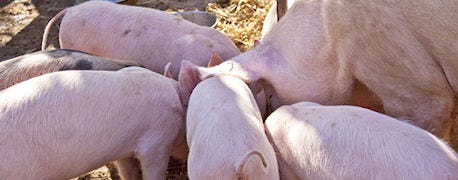April 16, 2015

This article originally appeared on farmdocDAILY. For the full version, click here. Hurt is an ag economist with the Purdue University.
More hogs than expected was the theme of the pork market in the first quarter of 2015. The USDA March Hogs and Pigs report did little to help explain why hog numbers were high, other than to simply admit that hog inventory counts from previous surveys were too low.

Hog numbers continue to surpass expectations
At the start of 2015, pork supplies in the first quarter were expected to rise 1%. In reality, first quarter pork production was up 5% due to 4.5% more hogs and 0.5% higher weights. There is currently an even more price depressing force as the number of hogs coming to market in the most recent four weeks has remarkably been 10% higher than year-ago levels. Higher than expected current numbers may mean that the breeding herd expansion is larger than USDA surveys have indicated and/or that PED death losses were smaller than producers reported to USDA. If there has been an undercount of animals, the possibility remains for higher market numbers than anticipated for the remainder of the year.
As a result of the higher actual marketings in the first quarter, USDA revised last summer's pig crop upward by nearly 3%. As always, "the proof is in the pudding" meaning that if actual winter slaughter is higher than accounted for by last summer's pig crop, last summer's pig crop has to be revised upward. USDA did this by increasing the estimated number of farrowings.
Has there been more expansion of the breeding herd? While USDA raised the size of last summer's farrowings, the size of the breeding herd was not increased. This still leaves unanswered the question of whether the breeding herd is actually higher, which would indicate that the breeding herd has expanded more rapidly than indicated by USDA survey numbers. If the breeding herd has expanded more rapidly than future animal numbers may also be higher than indicated by the USDA counts.
Coming full circle
So, we have come full circle. More pigs coming to market in the first quarter than expected must have come from a larger breeding herd.
Current marketing numbers have been averaging 10% higher. If the marketing herd is larger, then marketing numbers could continue to surprise the market on the high side and hog prices will stay depressed.
How will the current uncertainties of market supplies be resolved? Market participants will watch daily and weekly hog numbers coming to market. The best proof of the size of the pig crop about six months ago is the number of hogs coming to market today. Over time, USDA will likely be able to better resolve the differences and to give a clearer picture of future market supplies.
~~~PAGE_BREAK_HERE~~~
The impacts of the PED virus are likely tied to the current uncertainties in the numbers. PED caused disruptions to the pork industry beginning late in 2013. The largest impact on baby pig death losses was from late 2013 into the summer of 2014. The summer of 2014 is when current inconsistencies in USDA numbers prevail. The numbers that producers reported to USDA could have been influenced by their concerns over the impacts of PED at that time.
The impacts of PED on the number of pigs per litter appears to have been smaller this winter compared to the previous winter. In the winter of 2014, the number of pigs per litter was down about 7% from trend. In the recent winter, the number of pigs per litter was only about 2% below trend.
The current large number of hogs coming to market has caused cash prices and lean hog futures to be on the defensive. Moderation of these large numbers will be a requirement for price recovery. All indications are that the pork supply increases will remain high, but maybe not at the current rate that is up about 10%.
If USDA Hogs and Pigs numbers are used as the best estimate of future supplies, then pork production will be up by about 7% in the second quarter, followed by an 8% surge in the summer quarter. The hogs for the last quarter will come from this spring's farrowings where producers indicated a 2% increase. The number of pigs per litter this spring is expected to be about 5% to 6% higher, resulting in pork supplies in the last quarter of 2015 being higher by about 7% to 8%.
Current price forecast derived from futures prices for 2015 are for live hog prices to average about $51 per hundred pounds, down from the record high of $76 last year. My bias is that hog prices will recover some and post an average near $53. If so, projections by quarter would be around the following levels for quarters 1 to 4: $48, $54, $58, and $51, respectively.
With an average projected hog price near $53 per live hundredweight for 2015, costs are currently projected to be near $52 based on current feed price expectations. If so, this would mean a small profit of about $2 per head for the year, with the best of those profits in the third quarter and with small losses in the first and fourth quarters.
These lowly expectations for positive returns should keep producers from making further expansion plans.
You May Also Like




